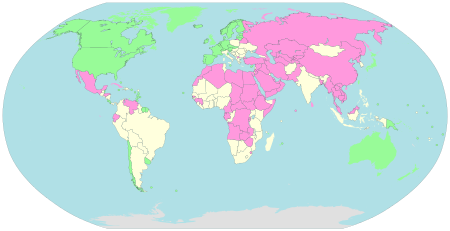Freedom of the Press (report): Difference between revisions
No edit summary Tag: Mobile app edit |
Somajeeste (talk | contribs) →Sub-Saharan Africa: List of Sovereign countries |
||
| Line 422: | Line 422: | ||
|- |
|- |
||
| {{flag| Sierra Leone}}|| ||53||style="background:#FFD;" | Partly Free |
| {{flag| Sierra Leone}}|| ||53||style="background:#FFD;" | Partly Free |
||
|- |
|||
| {{flag| Somaliland }}||21||54||style="background:#FFD;" | Partly Free |
|||
|- |
|- |
||
| {{flag| Tanzania }}||22||55||style="background:#FFD;" | Partly Free |
| {{flag| Tanzania }}||22||55||style="background:#FFD;" | Partly Free |
||
Revision as of 11:08, 29 March 2017
This article's factual accuracy is disputed. (April 2016) |

Column-generating template families
The templates listed here are not interchangeable. For example, using {{col-float}} with {{col-end}} instead of {{col-float-end}} would leave a<div>...</div> open, potentially harming any subsequent formatting. | Type | Family | Handles wiki table code?† | Responsive/ Mobile suited | Start template | Column divider | End template |
|---|---|---|---|---|---|---|
| Float | "col-float" | Yes | Yes | {{col-float}} | {{col-float-break}} | {{col-float-end}} |
| "columns-start" | Yes | Yes | {{columns-start}} | {{column}} | {{columns-end}} | |
| Columns | "div col" | Yes | Yes | {{div col}} | – | {{div col end}} |
| "columns-list" | No | Yes | {{columns-list}} (wraps div col) | – | – | |
| Flexbox | "flex columns" | No | Yes | {{flex columns}} | – | – |
| Table | "col" | Yes | No | {{col-begin}}, {{col-begin-fixed}} or {{col-begin-small}} | {{col-break}} or {{col-2}} .. {{col-5}} | {{col-end}} |
{| | || |- |} used to create tables? If not, special templates that produce these elements (such as {{(!}}, {{!}}, {{!!}}, {{!-}}, {{!)}})—or HTML tags (<table>...</table>, <tr>...</tr>, etc.)—need to be used instead.Freedom of the Press is a yearly report by US-based non-governmental organization Freedom House, measuring the level of freedom and editorial independence enjoyed by the press in nations and significant disputed territories around the world.

Percentage of countries in each classification by year
Column-generating template families
The templates listed here are not interchangeable. For example, using {{col-float}} with {{col-end}} instead of {{col-float-end}} would leave a<div>...</div> open, potentially harming any subsequent formatting. | Type | Family | Handles wiki table code?† | Responsive/ Mobile suited | Start template | Column divider | End template |
|---|---|---|---|---|---|---|
| Float | "col-float" | Yes | Yes | {{col-float}} | {{col-float-break}} | {{col-float-end}} |
| "columns-start" | Yes | Yes | {{columns-start}} | {{column}} | {{columns-end}} | |
| Columns | "div col" | Yes | Yes | {{div col}} | – | {{div col end}} |
| "columns-list" | No | Yes | {{columns-list}} (wraps div col) | – | – | |
| Flexbox | "flex columns" | No | Yes | {{flex columns}} | – | – |
| Table | "col" | Yes | No | {{col-begin}}, {{col-begin-fixed}} or {{col-begin-small}} | {{col-break}} or {{col-2}} .. {{col-5}} | {{col-end}} |
{| | || |- |} used to create tables? If not, special templates that produce these elements (such as {{(!}}, {{!}}, {{!!}}, {{!-}}, {{!)}})—or HTML tags (<table>...</table>, <tr>...</tr>, etc.)—need to be used instead.Methodology
The ratings process involves several dozen analysts (Freedom House staff and consultants) who develop draft ratings using information gathered from professional contacts in a variety of countries, staff and consultant travel, international visitors, the findings of human rights and press freedom organizations, specialists in geographic and geopolitical areas, the reports of governments and multilateral bodies, members of the International Freedom of Expression Exchange (IFEX) network, and a variety of domestic and international news media. Countries are given a total score from 0 (most free) to 100 (least free) on the basis of a set of 23 methodology questions and 109 indicators divided into three broad categories covering the legal, political, and economic environment. Based on the scores, the countries are then classified as "Free" (0 to 30), "Partly Free" (31 to 60), or "Not Free" (61 to 100). The draft ratings are reviewed on an individual and a comparative basis, compared with the previous year’s findings, any major proposed numerical shifts or category changes are subject to more intense scrutiny, and assessments are made to ensure comparability and consistency in the findings from country to country, region to region, and year to year. While there is an element of subjectivity inherent in the rating process, it emphasizes intellectual rigor, recognizes cultural differences, diverse national interests, and varying levels of economic development, and attempts to produce balanced and unbiased ratings.[3]
2016 report
The Freedom of the Press 2016 report covers events that took place between 1 January 2015 and 31 December 2015.[4]
| Key: | Not Free
|
Partly Free
|
Free
|
Americas
|
|
Asia-Pacific
|
|
Eastern Europe, Former Soviet Union
|
|
Middle East and North Africa
|
|
Sub-Saharan Africa
|
|
Western Europe
|
|
See also
References
- ^ "Scores and Status Data 1980-2015". Freedom of the Press 2015. Freedom House. Retrieved 12 June 2015.
- ^ "Freedom of the Press 2015". Freedom of the Press Category Breakdown Data: Global Category Breakdown 1989-2015. Freedom House. Retrieved 11 June 2015.
{{cite web}}: External link in|work=|work=(help) - ^ "Methodology", Freedom of the Press 2012, Freedom House, 21 June 2012, retrieved 2 August 2012
- ^ "Freedom of the Press 2016". Freedom House. 27 Apr 2016. Retrieved 1 May 2016.
